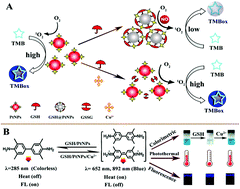Our official English website, www.x-mol.net, welcomes your
feedback! (Note: you will need to create a separate account there.)
Molecule-gated surface chemistry of Pt nanoparticles for constructing activity-controllable nanozymes and a three-in-one sensor.
Analyst ( IF 3.6 ) Pub Date : 2019-12-23 , DOI: 10.1039/c9an01956a Min Gao 1 , Pengli An , Honghong Rao , Zhengrong Niu , Xin Xue , Mingyue Luo , Xiuhui Liu , Zhonghua Xue , Xiaoquan Lu
Analyst ( IF 3.6 ) Pub Date : 2019-12-23 , DOI: 10.1039/c9an01956a Min Gao 1 , Pengli An , Honghong Rao , Zhengrong Niu , Xin Xue , Mingyue Luo , Xiuhui Liu , Zhonghua Xue , Xiaoquan Lu
Affiliation

|
Herein, a simple strategy for constructing activity-controllable nanozymes is proposed based on the glutathione (GSH)-gated surface chemistry of citrate-capped Pt nanoparticles (PtNPs). PtNPs have been shown to have oxidase-like activity that can effectively catalyze the oxidation of 3,3',5,5'-tertamethylbenzidine (TMB) by O2, resulting in a typical color reaction from colorless to blue. We found that GSH can inhibit the oxidase-like activity of PtNPs as a molecule-gated surface chemistry element, resulting in a dramatic decrease of the oxidation of TMB. The addition of copper ions (Cu2+) could oxidize GSH into glutathione disulfide (GSSG), resulting in the distinct suppression of GSH-modulated PtNP surface chemistry and oxidase-like activity inhibition, which further results in a significant acceleration of TMB oxidation and the obvious recovery of intense blue color. Furthermore, the color-based detection signal associated with the redox of TMB indicator here was found to show good fluorescence and a photothermal effect and exhibit sensitive and selective response toward the proposed molecule-gated surface chemistry and Cu2+ target. On the basis of this phenomenon, we successfully constructed a three-in-one sensor for Cu2+ with a triple signal readout, colorimetric, photothermal (temperature), and fluorescence, depending on the proposed in situ modulation method for PtNP catalysis. The applicability of the three-in-one sensor was also demonstrated by measuring Cu2+ in human serum with a standard addition method, and the results are of satisfactory accuracy as confirmed by ICP-MS measurements.
中文翻译:

Pt纳米颗粒的分子门控表面化学,用于构建活性可控的纳米酶和三合一传感器。
本文中,基于柠檬酸盐封端的Pt纳米颗粒(PtNP)的谷胱甘肽(GSH)门控表面化学,提出了构建活性可控的纳米酶的简单策略。已显示PtNP具有类似氧化酶的活性,可以有效地催化O2氧化3,3',5,5'-叔甲基联苯胺(TMB),导致典型的从无色到蓝色的显色反应。我们发现GSH可以抑制PtNPs的氧化酶样活性作为分子门控的表面化学元素,从而导致TMB的氧化显着降低。加入铜离子(Cu2 +)可以将GSH氧化为谷胱甘肽二硫化物(GSSG),从而显着抑制GSH调节的PtNP表面化学反应并抑制类似氧化酶的活性,这进一步导致TMB氧化的显着加速和深蓝色的明显恢复。此外,在这里发现与TMB指示剂的氧化还原相关的基于颜色的检测信号显示出良好的荧光和光热效应,并且对拟议的分子门控表面化学物质和Cu2 +靶标表现出敏感和选择性的响应。基于这种现象,我们成功地为Cu2 +构建了三合一传感器,具有三重信号读数,比色,光热(温度)和荧光,这取决于拟议的PtNP催化原位调制方法。通过使用标准添加方法测量人血清中的Cu2 +也证明了三合一传感器的适用性,并且通过ICP-MS测量证实了结果具有令人满意的准确性。
更新日期:2020-02-17
中文翻译:

Pt纳米颗粒的分子门控表面化学,用于构建活性可控的纳米酶和三合一传感器。
本文中,基于柠檬酸盐封端的Pt纳米颗粒(PtNP)的谷胱甘肽(GSH)门控表面化学,提出了构建活性可控的纳米酶的简单策略。已显示PtNP具有类似氧化酶的活性,可以有效地催化O2氧化3,3',5,5'-叔甲基联苯胺(TMB),导致典型的从无色到蓝色的显色反应。我们发现GSH可以抑制PtNPs的氧化酶样活性作为分子门控的表面化学元素,从而导致TMB的氧化显着降低。加入铜离子(Cu2 +)可以将GSH氧化为谷胱甘肽二硫化物(GSSG),从而显着抑制GSH调节的PtNP表面化学反应并抑制类似氧化酶的活性,这进一步导致TMB氧化的显着加速和深蓝色的明显恢复。此外,在这里发现与TMB指示剂的氧化还原相关的基于颜色的检测信号显示出良好的荧光和光热效应,并且对拟议的分子门控表面化学物质和Cu2 +靶标表现出敏感和选择性的响应。基于这种现象,我们成功地为Cu2 +构建了三合一传感器,具有三重信号读数,比色,光热(温度)和荧光,这取决于拟议的PtNP催化原位调制方法。通过使用标准添加方法测量人血清中的Cu2 +也证明了三合一传感器的适用性,并且通过ICP-MS测量证实了结果具有令人满意的准确性。











































 京公网安备 11010802027423号
京公网安备 11010802027423号